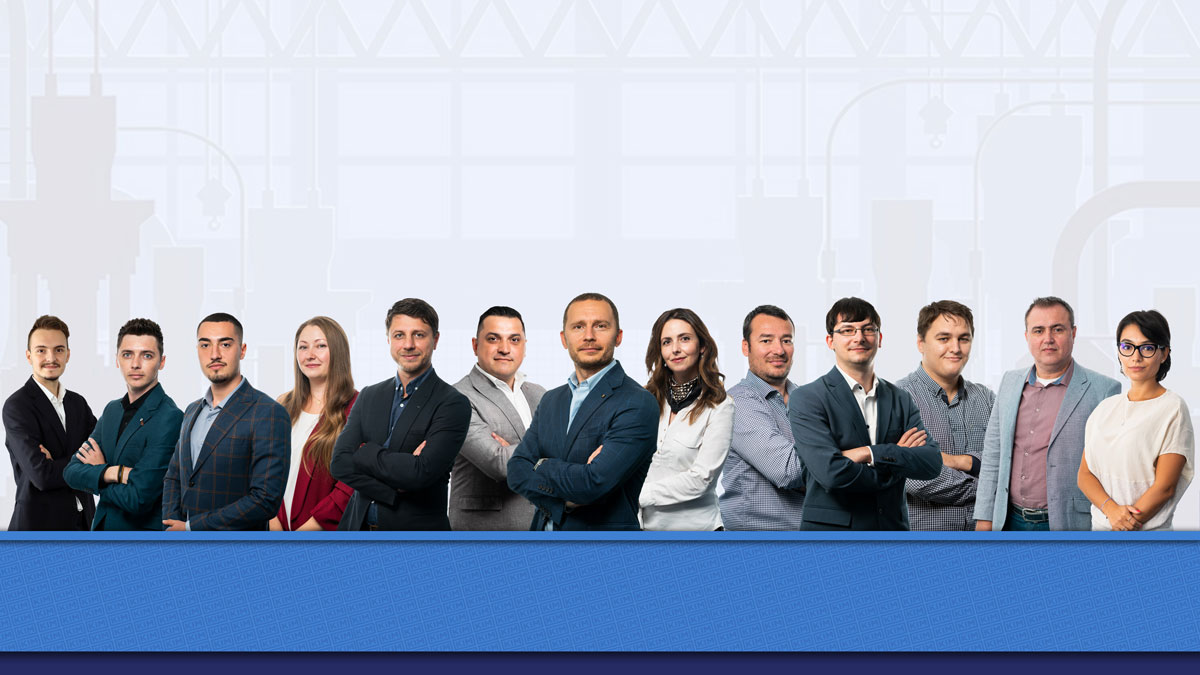Vicentiu Corbu: KIM Solutions to Thrive in the New Digital Era
Vicentiu Corbu, CEO of KIM, reveals the importance of software solutions as we move into the new era of digital transformation.
KIM is a high-tech software company operating in the field of mobile development for Industrial sectors. The company delivers high-reliable software solutions for Manufacturing, Oil & Gas, Logistics and Aviation industries by integrating barcode engines, RFID or NFC technologies in high-risk industrial zones and across all business sectors.
Vicentiu Corbu studied Information Technology and Mathematics at Petroleum-Gas University of Ploiesti with a master’s degree in Computer Science.
He is currently in the process of graduation of the MBA program at Vienna University of Economics and Business Administration (WU).
Vicentiu Corbu has extensive knowledge in start-ups, business planning, project management and software development. He projected and developed software solutions for Corobor Systems, a French company based in Paris, with systems for the aviation industry and customers in over 130 countries.
Vicentiu Corbu founded KIM in 2012 and since then, together with his team he built and delivered several successful software applications for the Industrial sector, creating a strong network of international clients and business partners.
Mr. Corbu, what do you mean by Keep It Mobile? What are your company’s purpose and areas of interest? Why and how did everything start?
Vicentiu Corbu: In 2012, when we launched, the problem that we identified in the industrial sector was the lack of mobility. A lot of activities were done in the field without being transmitted in any system. It was not like someone didn’t want to send them, but it was literally impossible to do that in an efficient way. That is why we realised that we need something as simple as possible to solve this issue, something related to the “Keep IT Simple” motto, but mobile… so we came out with “Keep IT Mobile”.
After 2 years of teasing the market, in 2014 we released our first prototype in Oil & Gas industry, a prototype that introduced for the first time NFC technology into oil extraction zones.
By 2016, we moved forward with this solution, and we won the Seal of Excellence in Horizon 2020 program for innovation, being the first Romanian company winning Phase II.
In 2017, after months of research in factories, in shipyards or construction sites, we released another two modules dedicated to Manufacturing & Logistic sectors.
With an increasing role in the energy sector, software must answer its biggest challenge – the energy transition. What is the importance of a business software solution for a company on the path to competitiveness?
Vicentiu Corbu: Driven by the pandemic, companies have discovered that automation can open up new horizons, new opportunities, and growth can be phenomenal. The new dynamic was an alarm signal to improve the efficiency in order to cope with such shocks. For some companies, process automation can be vital in meeting new market demands. For example, if a company exponentially grows its operations, it cannot sustain the workflows with the same software used at the beginning of the road in order to be competitive in the market.
The energy transition represents also a new pillar that needs to be taken into account when designing the IT infrastructure. Things like energy consumption for factory equipment or raw material preservation didn’t represent a necessary priority before.
In the new reality, the software solutions have to adapt to these needs, preferably without dramatically changing an existing infrastructure. Software for process automation represents a solution for these demands, especially for the fact that it can be added to an existing infrastructure.
KIM for Field Service uses mobility and Industry 4.0 techniques to streamline live maintenance and repair operations, independently or using integration with company ERPs, offering the real-time visibility, and tracking of actual work orders, operations, and associated activities.
Implementing KIM, allows organizations to make sure that maintenance happens as scheduled, on the right assets, with the right materials and by the proper technicians. It documents all stages of activity, impediments, blockers, and results for further review.

By leveraging digital technology, manufacturers can improve speed, efficiency, decrease costs and offer elevated customer experiences. What kind of software products do KIM provide for the customers?
Vicentiu Corbu: KIM has a set of modules able to automate the field activity in order to improve operators’ efficiency and reduce waste.
In the FrontEnd, the solution uses mobile technologies, NFC or QR to collect the field data in real-time and in the BackEnd we are using AI and machine learning to adapt to the behaviour of the field operators and connect them with the existing IT infrastructure.
What are KIM for Manufacturing main benefits and the novelty of this solution?
Vicentiu Corbu: KIM novelty comes from the technology that we developed, which allows our customers to obtain a clear set of benefits from the first moment of using the product.
One of the main key benefits that was confirmed by our users comes from the production planning that is automatically achieved on each production machine, where we succeeded in highly decreasing the energy cost. Also, in terms of productivity, because of the real-time visibility of the production process, our customers are now able to contract a higher number of orders and gain more revenue.
Also, taking in consideration the actual world challenge in the supply chain, we managed to obtain a cash-flow optimization because the system helps the purchasing department to order the exact amount of material at the exact moment in time.
But the most valuable asset of this product stands in the fact that it has embedded decades of experience in process automation acquired from our customers combined with our experience in digitalization. That is why, through the technology that we developed, we succeeded in reducing the implementation time to almost a few weeks and the experience for the end-user highly improved in simplicity. Basically, the product is used by operators of any age, without any IT skills required.
KIM for Manufacturing gives you the real-time control over the production planning, production follow-up or documents and optimises the flows and stocks of raw materials, semi-finished and finished goods through different stages of production. It intelligently combining mobility, digital labelling, and full functionality from MES (Manufacturing Execution System), MRP (Material Resource Planner) and production-oriented WMS (warehouse management systems).
Implementing KIM allows transparent tracking of production and warehousing operations and supervises in real time the actual usage of personnel, equipment and materials.

How do you evaluate the data and make the knowledge gained available at the right place and at the right time in the processes and product channels?
Vicentiu Corbu: The system can be used in any type of configuration, either stand-alone or connected to the existing systems.
In case of a stand-alone approach, all the data regarding WMS (warehouse management system), MES (Manufacturing Execution System) and MRP (Manufacturing Resource Planning) are managed completely by KIM.
When connecting with existing ERP systems, we use the information regarding work orders, technology flow, warehouse and purchasing recorded in the ERP and we update it in real-time with the data collected and processed from the field.
In the same manner, we collect data from all available sources, like manufacturing machines, nesting solutions, etc.
After collecting the data, the next step is to provide each technician from the production chain with the exact information that he needs, at the right time and with the exact quantity of raw material.
KIM FOR LOGISTICS: AUTOMATE YOUR WAREHOUSE AND TRACE YOUR ASSETS
Today the pandemic has created a significant shift for construction firms and tech adoption is the only way forward to embrace the “next normal.” Digitalization will also enable construction managers to define new business and operating models.
To eliminate inefficient processes that plague the industry’s productivity caused by ineffective communication and inaccurate project data, going digital is the only way forward.
We have developed software solutions in order to help the industry overcome these challenges and adopt a smart way in running the business.
KIM for Logistics offers real-time access to updated inventory of fixed assets or tools and their movements by quickly identify them through scanning the attached labels (NFC, RFID, QR, barcode).

The digital transformation era is adding to the other challenges, as pandemic for instance, calls for a shift in leadership mindset. As a leader, how do you cope with change and disruption? How do you take decisions and identify valuable opportunities?
Vicentiu Corbu: The challenges that we saw in the last years, the pandemic, and the war with all their side-effects, showed that we need not just to accept the change but to embrace it. We live in a VUCA (Volatility, Uncertainty, Complexity and Ambiguity) world and leaders must adapt to that configuration.
In all my decisions I have one top priority and that goes to the people that I work with… my colleagues, customers, partners. I think this is the most valuable thing that we learned from the past, that in difficult situations we need to have the support of the team and act united with strength and clarity.
What are the most important aspects that should be considered to provide customers in the age of digitalization with optimal software solutions?
Vicentiu Corbu: In 2022, as more organisations are leveraging the power of automation as they navigate towards recovery, the significance of the technology is ever increasing. In a recent survey of IT and engineering leaders by Gartner, 74% of respondents said that automation had helped their workforce work more efficiently, with 59% reported cost reduction up to 30%.
The current political and economic context revealed that there are few aspects that are vital, one is related to energy management/preservation and the other one is related to climate change. So basically, if through our solutions we are able to address these two needs, then we as a society are on a good track, creating a better world for our children.
KIM’S JOURNEY IN THE INNOVX-BCR BUSINESS ACCELERATOR. AWARDED BY COLLIERS, DLA PIPER ROMANIA AND MICROSOFT
KIM entered at the beginning of this year in the InnovX-BCR business accelerator with the aim to be part the most ambitious hubs of entrepreneurial innovation in Central and Eastern Europe and scale by pitching to the investors of this intense program.
After the Pre-acceleration phase, KIM is made it in top 10 Innovators to go in the Acceleration Phase.
In the Acceleration Phase, KIM obtained the highest number of awards granted by the investors and partners of the program: Colliers, DLA Piper, and Microsoft.
KIM Milestones in 10 years of activity
- In 2014 – the first implementation of a solution based on NFC technology in the oil and gas industry. Winning the Seal of Excellence in the European Union’s Horizon 2020 program
- Carrying out market research in order to develop their own software products
- Development and launch of several products, 3 of which have a high degree of adoption
- 8 production plants digitalized, partnership with 6 multinationals and 20+ SMEs for continuing the products R&D
- Entering in 5 European markets
- Saving over 1 million hours of labor each year and over 20.000 tons of materials
2021 – KIM received an investment from Andrei Pitiș through Simple Capital for accelerate the scaling process - Developed a coherent marketing strategy and successfully complete the rebranding process

Who are your customers and major ongoing projects? Compared to other countries has Romania a greater appetite for digitalisation?
Vicentiu Corbu: Our customers come from two main directions, one is the manufacturing sector and the other one is the services sector. Until now, we managed to digitalize companies with more than 500 employees on average with subsidiaries in multiple countries. This year we made the transition to the SaaS path and our solutions can be deployed also to small and medium companies.
Referring to the energy industry, some good examples of successful projects are Conpet S.A, Inspet S.A. or OMV Petrom, where with support from our partners, we obtain high returns in terms of efficiency and productivity.
Romania started a good journey for digitalization. More and more companies realise that this is the best chance for growth. Also, based on the feedback from our customers, it seems that many companies succeeded in opening new lines of business with help of specific software solutions.
For example, we have customers that added some of our products in their portfolio for their clients, as added value for their existing services.
So, digitalization can open new horizons not only in terms of reducing costs but also for developing new businesses with existing resources.

What are KIM’s long run strategic plans? Do you intend to expand into international markets?
Vicentiu Corbu: Our scaling plans targets in the first stage EU countries and then the US market.
We are in discussions with international partners to start collaboration and by the end of this year we will have the first results.
In the face of constantly evolving technologies and trends shaping the future, what are the most performance tools to drive the transformational change that leads to business results, in your view?
Vicentiu Corbu: Nowadays, there has been more and more emphasis on sustainability, social responsibility, but also awareness of climate challenges; thus, digital transformation should be a top priority in achieving these goals.
Each project should target at least one of the 17 SDGs adopted by the United Nations, most of the EU funds already addressing these objectives.
That is why, in the digital transformation process, I think the projects that reach these goals have the best chances to succeed.







